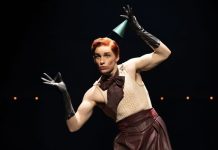Largely overlooked in the annals of art history and forgotten over time, Polish painter Tamara de Lempicka (1898-1980) was active in France and the US in the period spanning the two World Wars and beyond, creating stylized portraits of wealthy patrons and aristocrats, still lifes, and abstracted nudes in the Art Deco era, combining elements of the Cubist and Neo-Classical styles. As much as for her work, Lempicka was known for her social life in the artistic and literary circles of Paris, her enjoyment of alcohol, cocaine, and cigarettes, and her then scandalous sexual exploits with both men and women. Following her death, her art was rediscovered and collected by such celebrities as Barbra Streisand, Madonna, and Jack Nicholson, a retrospective of her paintings was exhibited at London’s Royal Academy of Arts in 2004, and her 1932 Portrait of Marjorie Ferry sold for $21.2 million in 2020, placing it in the top ten most expensive works by a woman to sell at auction. She has now become the subject of the eponymous new musical Lempicka by Carson Kreitzer (book, lyrics, and original concept) and Matt Gould (book and music), spanning the decades of her life, art, and times.
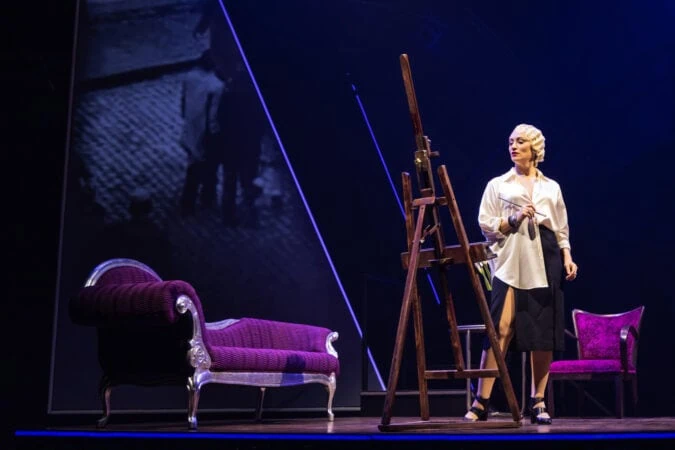
Presented in the framing device of a memory play, the older Lempicka, sitting alone on a park bench in Los Angeles in 1975, easel by her side and feeling “Unseen,” reflects on “How did I end up here?” and queries, “Do you know who I am?” Under the boisterous direction of Rachel Chavkin, a featured cast of eight and ensemble of ten tells us, belting out 22 songs in a variety of styles, from pop to show tune, ballad to torch song, painting a portrait, in a rapid-fire chronology, of the tumultuous historical events of the 20th century, her driving dedication to her art, and her conflicted personal relationships, slyly noting at the outset of the go-back story that she loved two times – unfortunately, both at once (and neither of which ended well).
A modernist multi-level openwork metal set by Riccardo Hernández, which takes its inspiration from the Eiffel Tower, shifts from Poland to Paris, with projections by Peter Nigrini that identify the years, locales, and socio-political turmoil, and provide details of the artist’s paintings (oddly not present in the many empty picture frames and easels at which she paints), linear Deco-style neon lights and focused spotlights by Bradley King, and costumes by Paloma Young that define the characters, their eras and situations, including the military uniforms of the Russian Revolution and the Fascists of WWII, suggestive sex-worker attire and hedonistic club wear (think Josephine Baker meets Cabaret), and the expensive dress and jewels of the upper classes, into which the socially conscious Lempicka was born and married (first to the lawyer Tadeusz Lempicki, then to The Baron, who supported her career and collected her paintings).
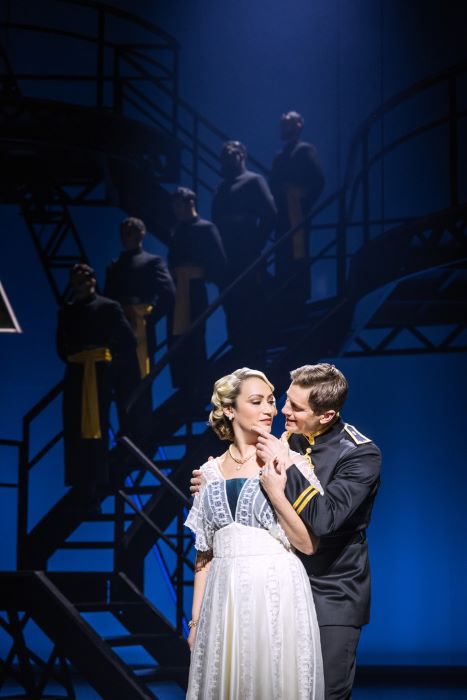
Eden Espinosa stars in the titular role, manifesting the contradictory and self-absorbed nature of Lempicka, who claims to love her husband and goes to all lengths, giving away her diamonds and her body, to have him freed from imprisonment by Bolshevik revolutionaries, but spends more time in her studio than with him, takes her model and muse Rafaela, a prostitute, as her lover, and refuses to return to Poland with him. Her perspective and passion are evident in her high-decibel numbers (with a few flat long notes), and in her definition of what “Woman Is” – one of several songs devoted to her ostensibly progressive behavior (though her art and life are largely sexualized – so nothing especially new there in the view or depiction of women).
As Tadeusz, Andrew Samonsky brings his masterfully controlled and outstanding voice to the couple’s hopeful song “Starting Over,” his acceptance of his wife’s self-determination in “The New Woman,” and mutual recognition of “What She Sees” in his accidental meeting and duet with Rafaela. Amber Iman delivers an appropriately equivocating characterization of the proud and bold Rafaela, born in a whorehouse, painted and bedded by Lempicka, in love with her, but convinced that “love is for fools” and hurt by the artist’s refusal to let her be seen or invited to her exhibitions and openings, or to remain with her in Paris, as expressed in her blockbuster solos “The Most Beautiful Bracelet” and “Stay.” And Zoe Glick as Lempicka’s daughter Kizette is largely neglected, bored with posing for her, told to call her Chérie so people won’t know she’s old enough to be her mother, and cavalierly subjected to her extra-marital trysts with Rafaela in the studio (sharing her feelings in the song “Mama Look at Me”).
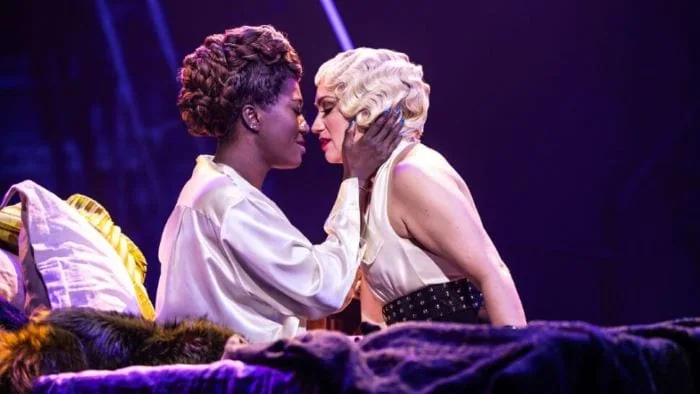
Contributing over-the-top dark humor to the show is George Abud’s caricatural portrayal of Lempicka’s art teacher Marinetti, a Futurist who decries humanity in favor of the machines he sees as “Perfection” and a Fascist who proclaims that “Pari Will Always Be Pari.” Also featured are Natalie Joy Johnson as Suzy Solidor, a cabaret singer in Paris and friend of Lempicka, who opens the nightclub Le Monocle, where lesbians could meet, socialize, and revel in being and loving “Women;” Nathaniel Stampley as The Baron, an advocate for her art (with whom she was also having an affair, though that’s not made clear in the present show), who weds her and makes her “The Baroness with a Brush” after the death of his wife, and leaves with her for America after the outbreak of WWII; and Beth Leavel, who turns in an emotionally compelling performance as The Baroness, attending Lempicka’s gallery exhibitions with her husband, coming to appreciate her work, commissioning a portrait of herself when she’s dying for him to remember her by, and selflessly encouraging the artist to be with him after she’s gone, in the sensitive song “Just This Way” – a soft and moving highlight of the generally booming show and score (with sound by Peter Hylenski and Justin Stasiw, orchestrations by Cian McCarthy, Charity Wicks serving as music director, and Remy Kurs as music supervisor).
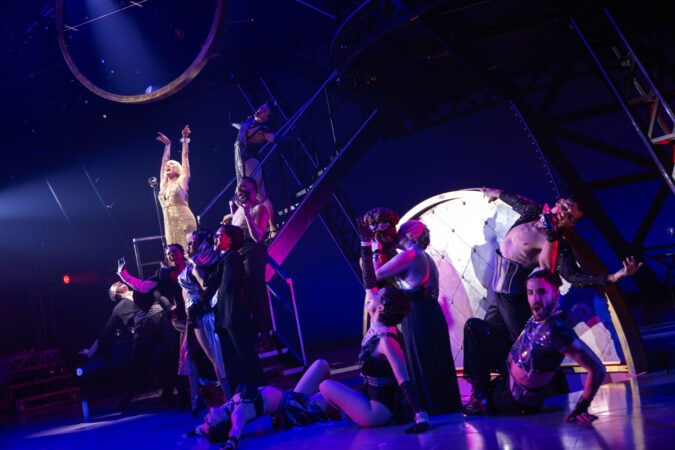
Rounding out the company is the ensemble of back-up singers and dancers (Alex Aquilino, Lauren Blackman, Stephen Brower, Kyle Brown, Holli’ Conway, Abby Matsusaka, Jimin Moon, Khori Michelle Petinaud, Ximone Rose, and Nicholas Ward), who perform the overly affected and decadent moves of Raja Feather Kelly’s stylized choreography, with nods to the archetypes of the eras.
Lempicka offers a theatrical manifestation of the revival of interest in a woman artist who embraced the avant-garde style of Art Deco, along with a privileged lifestyle and free sexuality, as stated in her own bombastic and defiant words: “I live life in the margins of society, and the rules of normal society don’t apply to those who live on the fringe.” If only the sexualization of women and their nudity in art were not so standard. As questioned in the famous poster by the feminist/activist group Guerrilla Girls in 1989, “Do women have to be naked to get into the Met Museum?,” noting that “less than 5% of the artists in the Modern Art section were women, but 85% of the nudes were female.”
Running Time: Approximately two hours and 35 minutes, including an intermission.
Lempicka plays through Sunday, September 8, 2024, at the Longacre Theatre, 220 West 48th Street, NYC. For tickets (priced at $46-269, plus fees), call (212) 239-6200, or go online.




